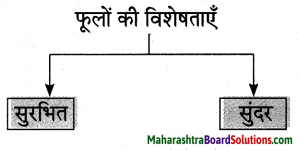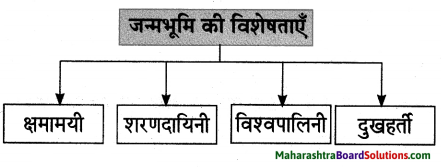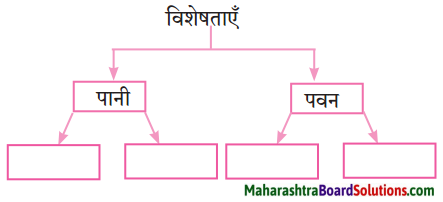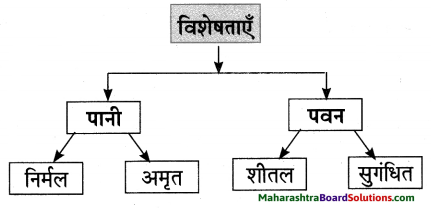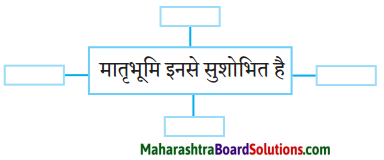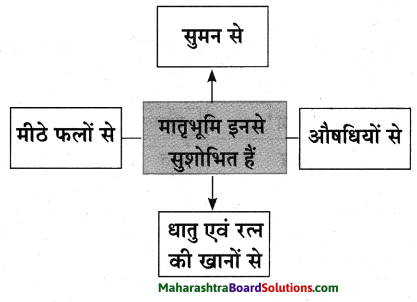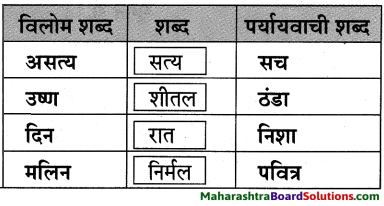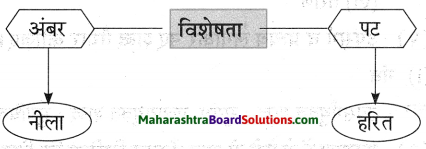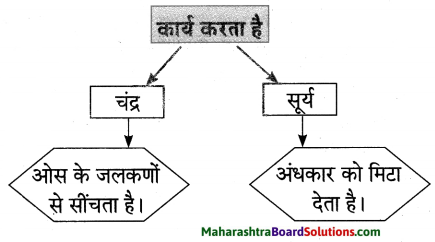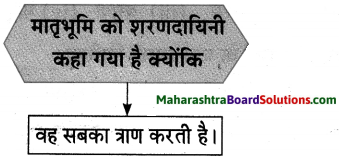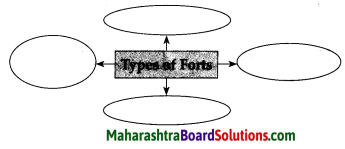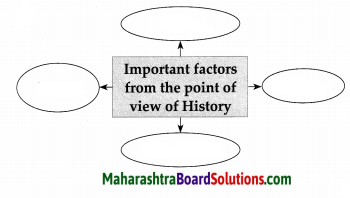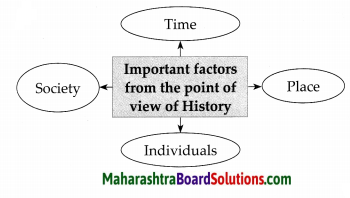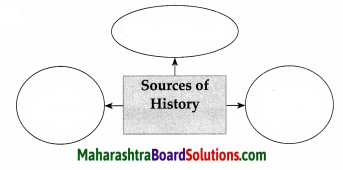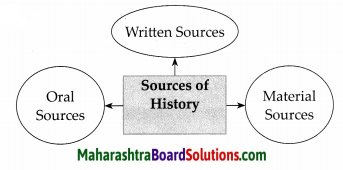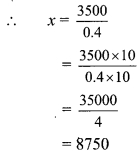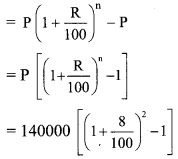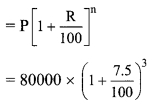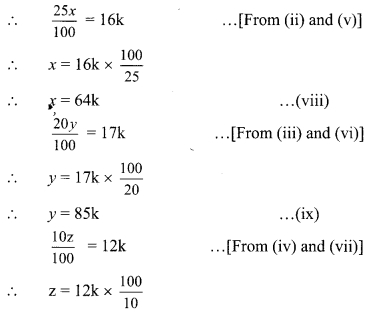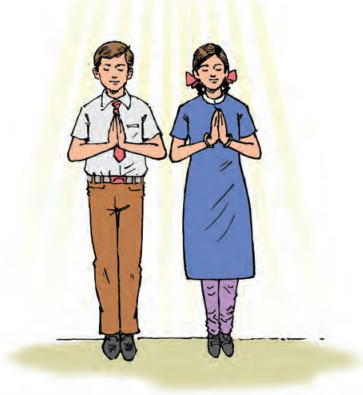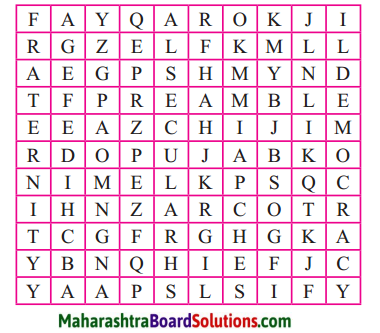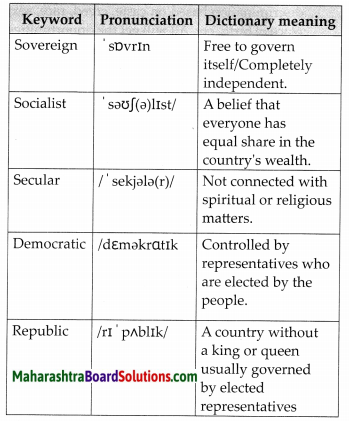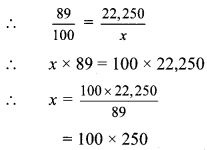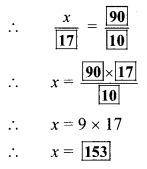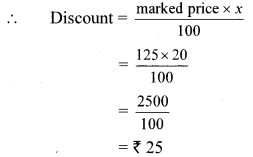Balbharti Maharashtra State Board Class 10 Sanskrit Solutions Amod Chapter 1 आधकृषकः पृयुवैयः Notes, Textbook Exercise Important Questions and Answers.
Maharashtra State Board Class 10 Sanskrit Amod Solutions Chapter 1 आधकृषकः पृयुवैयः
Sanskrit Amod Std 10 Digest Chapter 1 आधकृषकः पृयुवैयः Textbook Questions and Answers
भाषाभ्यासः
1. पूर्णवाक्येन उत्तरं लिखत ।
प्रश्न अ.
चारणा: किमर्थम् उत्सुका: ?
उत्तरम् :
चारणा: पृथुनृपस्य स्तुति गातुम् उत्सुकाः ।
प्रश्न आ.
भ्रमणसमये पृथुराजेन किं दृष्टम् ?
उत्तरम् :
भ्रमणसमये पृथुराजेन दृष्टं यत् प्रजा: अतीव कृशाः अशक्ता: च। ता: पशुवत् जीवन्ति। निकृष्टान्नं खादन्ति।

प्रश्न इ.
वसुन्धरायाः उदरे किं वर्तते?
उत्तरम् :
वसुन्धरायाः उदरे धनधान्यादि सर्व वस्तुजातं वर्तते।
प्रश्न ई.
स्त्रीरूपं धृत्वा पृथुनृपस्य पुरतः का प्रकटिता अभवत् ?
उत्तरम् :
स्त्रीरूपं धृत्वा पृथुनृपस्य पुरतः भूमिः प्रकटिता अभवत्।
प्रश्न उ.
पृथुवैन्यः कृषिकार्यार्थं जलस्य व्यवस्थापनं कथम् अकरोत् ?
उत्तरम् :
पृथुवैन्यस्य नि:स्पृहताम् अजानन् स्तुतिगायकाः प्रसन्नाः अभवन् च।
2. माध्यमभाषया उत्तरत।
प्रश्न अ.
भूमाता पृथुवैन्यं किम् उपादिशत् ?
उत्तरम् :
आद्यकृषक: पृथुवैन्यः हा पाठ म्हणजे पृथु राजाच्या कृषिविषयक कार्याचा प्रारंभ व त्याचा विकास याचा इतिहास स्पष्ट करणारी आख्यायिका आहे.
एकदा पृथु राजा त्याच्या राज्यात फिरत असताना त्याने प्रजेला दयनीय अवस्थेत पाहिले. त्याच्या राज्यातील लोक हलक्या प्रतीच्या अन्नामुळे क्षीण, अशक्त झाले होते. हे पाहून राजाचे मन द्रवले व तो चिंताग्रस्त झाला.
पुरोहितांच्या सांगण्यानुसार त्याने पृथ्वीमधून धन-धान्य बाहेर काढण्याकरिता धनुष्य सज्ज केले. तेव्हा पृथ्वीने स्वी-रूप धारण केले व राजाला कृषिकार्य करण्याचा आदेश दिला. भूमातेने नांगर, कुदळ, फावडे, कोयता या उपकरणांच्या साहाय्याने राजाला कृषिकार्य करण्यास सांगितले. भूमातेने राजाला त्याच्या अन्यायी वडिलांचा संदर्भ दिला तसेच त्यावेळी राजाच्या सदाचरणाचे कौतुक केले आणि राजाच्या कृषिकार्यावर तिची कृपा होईल, असे आश्वासन दिले.
आद्यकृषक: पृथुवैन्यः is the legend that reveals the history of Pruthu’s initiation of agricultural work and civilization Once, king was wandering in his kingdom. He saw the pitiable condition of his subjects. His subjects were thin and weak due to low-quality food. The king’s heart melted with compassion and mind was filled with worry.
On the advice of a priest, he set the bow. When he was about to take out wealth and grains from the earth, the earth disguised as a woman and advised him to do agricultural work.
The earth advised the king to work with the help of hoe, plough, spade, sickles along with his subjects. She reminded the king of his father who was the corrupt king. She praised the king’s righteous behaviour and assured him with her favour in agricultural work.

प्रश्न आ.
धरित्र्याः उपदेशं मनसि निधाय पृथुवैन्यः किं किम् अकरोत् ?
उत्तरम् :
आद्यकृषकः पृथुवैन्यः हा पाठ म्हणजे पृथु राजाच्या कृषिविषयक कार्याचा प्रारंभ व त्याचा विकास याचा इतिहास स्पष्ट करणारी आख्यायिका आहे.
राजाने नदीचा मार्ग अडविला व ते पाणी कृषिकार्यासाठी उपयोगात आणले. पावसाच्या पाण्याचा संचय करून पाण्याचे व्यवस्थापन केले. जमिनीला सुपीक करण्यासाठी राजाने विशेष प्रयत्न केले. नंतर लोकांनी धान्याच्या बिया पेरल्या. राजाने सुद्धा विविध प्रकारची बी-बियाणे गोळा करून, त्याचे संस्करण केले व प्रयत्नपूर्वक त्याची पेरणी केली. पाऊस झाल्यानंतर धान्यांत अंकुर फुटला. राजाच्या परिश्रमामुळे धान्यलाभ झाला व सगळी प्रजा अतिशय आनंदित झाली.
आद्यकृषक: पृथुवैन्य: is the legend that reveals the history of Pruthu’s initiation of agricultural work and civilization.
The king obstructed the river’s path for agricultural work. He stored the rain water and did the water-management. He took special efforts to make the land fertile. Afterwards, people sowed the seeds of grains. The king gathered varied seeds, refined it and sowed with efforts. After the rains, the sprouts were germinated and all subjects became happy by the gain of grains.

3. जालरेखाचित्रं पूरयत ।
प्रश्न अ.

उत्तरम् :
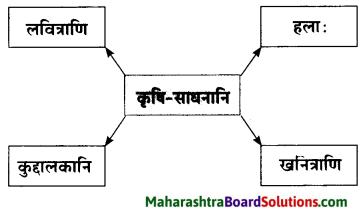
प्रश्न आ.
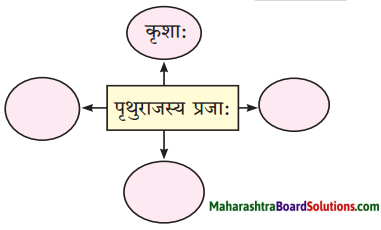
उत्तरम् :
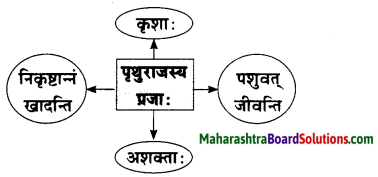
प्रश्न इ.
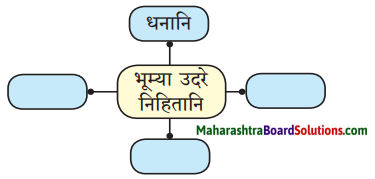
उत्तरम् :
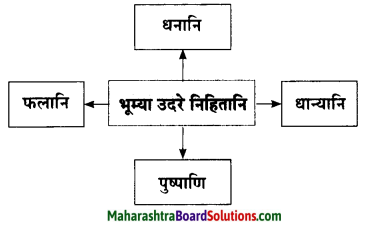
4. पाठ्यांशं पठित्वा प्रवाहिजालं पूरयत ।
प्रश्न 1.
पाठ्यांशं पठित्वा प्रवाहिजालं पूरयत ।

उत्तरम् :
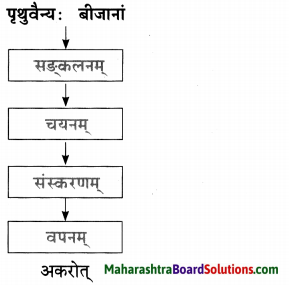
5. प्रश्ननिर्माणं कुरुत ।
प्रश्न अ.
प्रयागक्षेत्रे पृथुराजस्य राजधानी आसीत्।
उत्तरम् :
कुत्र पृथुराजस्य राजधानी आसीत्?

प्रश्न आ.
प्रजा: पशुवत् जीवन्ति।
उत्तरम् :
प्रजाः कथं जीवन्ति?
प्रश्न इ.
धनधान्यादि सर्व वस्तुजातं वसुन्धरावा: उदर एव वर्तते।
उत्तरम् :
धनधान्यादि सर्व वस्तुजातं कस्याः उदर एव वर्तते?
प्रश्न ई.
पर्जन्यानन्तरं बीजेभ्यः अङ्कुराः उद्भूताः।
उत्तरम् :
पर्जन्यानन्तरं केभ्यः अङकुराः उद्भूता:?
6. सूचनानुसारं कृती: कुरुत ।
प्रश्न अ.
पृथुवैन्यस्य नि:स्पृहतां ज्ञात्वा स्तुतिगायकाः प्रसन्नाः अभवन्। (पूर्वकालवाचक-त्वान्त-अव्ययं निष्कासयत ।)
उत्तरम् :
पृथुवैन्यस्य नि:स्पृहताम् भवान अजानन् स्तुतिगयकाः प्रसन्नाः अभवान् च ।

प्रश्न आ.
त्वं प्रयत्नेन कृषिकार्यं करोषि । (‘त्वं’ स्थाने ‘भवान्’ योजयत ।)
उत्तरम् :
भवान् प्रयत्नेन कृषिकार्यं करोति ।
प्रश्न इ.
त्वं धनुः त्यज।
उत्तरम् :
भवान् धनुः त्यजतु।
प्रश्न ई.
भूमातुः उपदेशं मनसि निधाय पृथुवैन्यः कृषिकार्यम् अकरोत् । (‘भूमातुः’ स्थाने ‘भूमि’ शब्दस्य योग्य रूपं लिखत ।)
उत्तरम् :
भूम्या: भूमेः उपदेशं मनसि निधाय पृथुवैन्यः कृषिकार्यम् अकरोत्।
प्रश्न उ.
प्रजाजनैः सह कृषिकार्यं कुरु । (लकारं लिखत) ।
उत्तरम् :
- लङ्लकार:
- लट्लकार:
- लृट्लकार:
- लोट्लकार:

7. मेलनं कुरुत ।
प्रश्न 1.

उत्तरम् :
| विशेषणम् |
विशेष्यम् |
| कृशाः |
प्रजाः |
| उर्वरा |
भूमिः |
| आनन्दिताः |
प्रजाजना: |
| दःशासकः |
वेनः |
| प्रजाहितदक्षः |
पृथुः |
8. समानार्थकशब्दं लिखत । वृक्षः, भूमिः, राजा, धनुः, नदी ।
प्रश्न 1.
समानार्थकशब्दं लिखत । वृक्षः, भूमिः, राजा, धनुः, नदी ।
उत्तरम् :
- वृक्षः – तरुः, महीरुहः, पादपः, द्रुमः ।
- भूमिः – पृथिवी, पृथ्वी, धरा, वसुन्धरा, अवनी, मही, मेदिनी, क्षमा, गोत्रा, कुः।
- राजा : – भूपालः, महीपतिः, नरेशः, नृपः, भूपः।
- धनुः - त्रिणता, चापः, शरासनः, कोदण्डः।
- नदी - तटिनी, निम्नगा, आपगा, सरित्।

9. विरुद्धार्थकशब्दं लिखत । स्तुतिः, सद्गुणाः, प्रसन्नाः, अशक्ताः, पुरतः, कृशाः ।
प्रश्न 1.
विरुद्धार्थकशब्दं लिखत । स्तुतिः, सद्गुणाः, प्रसन्नाः, अशक्ताः, पुरतः, कृशाः ।
उत्तरम् :
- स्तुतिः × निन्दा
- सद्गुणाः × दुर्गुणाः
- प्रसन्नाः × खिन्नाः, दुःखिताः, विषण्णाः
- अशक्ता: × सशक्ताः
- पुरतः × पश्चात्, पृष्ठतः
- कृशाः × पीवराः
10. कः कं वदति ?
प्रश्न अ.
तिष्ठन्तु चारणाः ।
उत्तरम् :
पृथुवैन्यः चारणान् वदति।

प्रश्न आ.
तत्प्राप्तुं यतस्व ।
उत्तरम् :
पुरोहितः पृथुवैन्यं वदति ।
प्रश्न इ.
तव पिता दुःशासकः।
उत्तरम् :
(for all sentences) भूमिः पथुवैन्यं वदति।
प्रश्न ई.
अत: धनुः त्यज ।
उत्तरम् :
(for all sentences) भूमिः पथुवैन्यं वदति।
11. सन्धिविग्रहं कुरुत ।
प्रश्न अ.
उदर एव
उत्तरम् :
उदर एव - उदरे + एव।

प्रश्न आ.
पशुवज्जीवन्ति
उत्तरम् :
पशुवज्जीवन्ति - पशुवत् + जीवन्ति ।
प्रश्न इ.
अशक्ताश्च
उत्तरम् :
अशक्ताश्च - अशक्ता : + च।
प्रश्न ई.
पुरोहितोऽवदत् ।
उत्तरम् :
पुरोहितोऽवदत् - पुरोहितः + अवदत्।
12. अमरकोषात् शब्दं प्रयुज्य वाक्यं पुनर्लिखत ।
प्रश्न अ.
भूमिः स्त्रीरूपं धृत्वा प्रकटिता ।
उत्तरम् :
गोत्रा / कु: । पृथिवी / पृथ्वी / क्ष्मा / अवनिः / मेदिनी / मही स्त्रीरूपं धृत्वा प्रकटिता।

प्रश्न आ.
भूपालः पृथुवैन्य: नाम धरायाः प्रथम: अभिषिक्तः सम्राट् ।
उत्तरम् :
राट् / पार्थिवः / क्षमाभृत् / नृपः / भूपः / महीक्षित् पृथुवैन्य: नाम धरायाः प्रथमः अभिषिक्तः सम्राट्।
Sanskrit Amod Class 10 Textbook Solutions Chapter 1 आधकृषकः पृयुवैयः Additional Important Questions and Answers
अवबोधनम् :
(क) उचितं कारणं चित्वा वाक्यं पुनर्लिखत।
प्रश्न 1.
स्तुतिगायकाः प्रसन्नाः अभवन् यतः
(अ) पाठकाः राज्ञः प्रशंसाम् अकुर्वन् ।
(ब) स्तुतिपाठकाः राज्ञः निःस्पृहताम् अजानन्।
उत्तरम्
(ब) स्तुतिपाठका: राज्ञः नि:स्पृहताम् अजानन्।
प्रश्न 2.
प्रजाः अतीव कृशाः अशक्ता: च यतः
(अ) ताः पशुवज्जीवन्ति निकृष्टानं खादन्ति च।
(ब) ता: मिष्टान्नं खादन्ति।
उत्तरम्
(अ) ता: पशुवज्जीवन्ति निकष्टानं खादन्ति च।

प्रश्न 3.
पृथुवैन्यः स्वप्रजाः दृष्ट्वा चिन्ताकुल: जात: यतः
(अ) तस्य प्रजाजनाः परस्परं वादविवादं कुर्वन्ति।
(ब) तस्य प्रजाजना: पशुवत् जीवन्ति।
उत्तरम्
(ब) तस्य प्रजाजनाः पशुवत् जीवन्ति ।
(ख) उचितं पर्यायं चित्वा वाक्यं पुनर्लिखत।
1. प्रजा: अतीव ……………. आसन्। (कृशाः / सुदृवाः)
2. सर्व वस्तुजातं …………. उदरे एव वर्तते। (धरायाः / सूर्यस्य)
उत्तरम् :
1. कशाः
2. धराया:
(ग) कः कं वदति ।
प्रश्न 1.
स्तवनं तु ईश्वरस्यैव भवेत्।
उत्तरम् :
पृथुवैन्यः चारणा बदति।
(घ) पूर्णवाक्येन उत्तरत।
प्रश्न 1.
कः धरायां प्रथम: अभिषिक्तः सम्राट्?
उत्तरम्
भूपालः पृथुवैन्य: धरायां प्रथम: अभिषिक्तः सम्राट्।

प्रश्न 2.
पृथुनृपस्य राजधानी कुत्र आसीत्?
उत्तरम् :
पृथुनृपस्य राजधानी प्रयागक्षेत्रे आसीत्।
प्रश्न 3.
के पृथुनृपस्य स्तुति गातुमुत्सुकाः?
उत्तरम् :
चारणाः पृथुनृपस्य स्तुतिं गातुमुत्सुकाः।
प्रश्न 4.
स्तुतिगायकाः किं ज्ञात्वा प्रसन्नाः अभवन्? / स्तुतिगायका: किमर्थ प्रसन्नाः अभवन्?
उत्तरम्
स्तुतिगायका: पृथुनृपस्य नि:स्पृहतां ज्ञात्वा प्रसन्नाः अभवन्।

प्रश्न 5.
पृथुः चारणान् किम् आज्ञापयत्?
उत्तरम्
पृथुः चारणान् स्थातुम् आज्ञापयत् अकथयत् च यावत् पृथो: सद्गुणा: न प्रकटीभवन्ति तावत् सः न स्तोतव्यः ।
स्तवनं तु ईश्वरस्य एव भवेत्।
प्रश्न 6.
राजा किमर्थ चिन्ताकुलः जातः?
उत्तरम् :
प्रजावा: दैन्यावस्थां दृष्ट्वा राजा चिन्ताकुलः जातः ।
प्रश्न 7.
चिन्ताकुलं राजानं पुरोहितः किम् अवदत् ?
उत्तरम्
चिन्ताकुलं राजानं पुरोहितः अवदत, ”हे राजन्, धनधान्यादि सर्व वस्तुजातं वस्तुत: वसुन्धराया: उदरे एवं वर्तते । तत्प्राप्तुं
प्रश्न 8.
एषः गद्यांश: कस्मात् पाठात् उद्धृतः?
उत्तरम्
एषः गद्यांश: आद्यकृषक: पृथुवैन्यः पाठात् उद्धृतः।

(च) वाक्यं पुनर्लिखित्वा सत्यम् / असत्यम् इति लिखत।
प्रश्न 1.
- पृथुवैन्यः नाम धरायाम् आदिम: सम्राट्।
- स्तवनं तु मानवस्यैव भवेत्।
- स्तुतिगायकाः पृथुनृपस्य नि:स्पृहतां ज्ञात्वा विषण्णा: अभवन्।
- पृथुराजेन दृष्टं यत् प्रजाः अतीव सशक्ताः ।
- प्रजा: पशुवत् जीवन्ति।
- धनधान्यादि वस्तुजातं वसुन्धराया: जठरे एव वर्तते।
उत्तरम् :
- सत्यम्।
- असत्यम्।
- असत्यम्।
- असत्यम्।
- सत्यम्।
- सत्यम्।
शब्दज्ञानम्
(क) सन्धिविग्रहः।
- गातुमुत्सुकाः - गातुम् + उत्सुकाः ।
- तावदहम् - तावत् + अहम्।
- ईश्वरस्यैव . ईश्वरस्य + एव ।
- तत्प्राप्तुम् - तत् + प्राप्तुम्।

(ख) विशेषण - विशेष्य - सम्बन्धः।
| विशेषणम् |
विशेष्यम् |
| 1. प्रथमः |
सम्राट |
| 2. अभिषिक्तः |
समाट् |
| 3. प्रसन्नाः |
स्तुतिगायकाः |
| 4. प्रजाः |
कृशाः |
| 5. प्रजाः |
अशक्ताः |
| 6. राजा |
चिन्ताकुल: |
(ग) चान्त-ल्यबन्त-तुमन्त-अव्ययानि।
| त्वान्त अव्यय धातु + त्वा / ध्या / टवा / ढवा / इत्वा / अयित्वा |
तुमन्त अव्यय धातु + तुम् / धुम् / टुम् / ढुम् / इतुम् / अयितुम् |
| दृष्ट्वा, ज्ञात्वा |
गातुम, प्राप्तुम् |
विभक्त्यन्तरूपाणि।
- प्रथमा - भूपालः, सम्राट्, राजधानी, चारणाः, अहम्, गायकाः, प्रजाः, ताः, राजा, पुरोहितः।
- द्वितीया - अन्नम्, सर्वम्।
- तृतीया - तेन।
- षष्ठी - नृपस्य, मम, ईश्वरस्य, वसुन्धरायाः।
- सप्तमी - धरायाम, क्षेत्रे, राज्याभिषेकसमये, स्वराज्ये।
- सम्बोधन - हे राजन्।

(च) लकारं लिखत।
प्रश्न 1.
- पृथुराजः स्वराज्ये भ्रमणम् अकरोत्।
- ता: मजा: पशुवत् जीवन्ति ।
- तत् प्राप्तुं यतस्व।
- तिष्ठन्तु चारणाः।
उत्तरम् :
- लङ्लकारः
- लट्लकारः
- लोट्लकार:
- लोट्लकारः
पृथक्करणम् :
प्रश्न 1.
- भ्रमणसमये तेन दृष्टं यत् प्रजा: अतीव कृशाः अशक्ता: च।
- पुरोहितेन उपायः कथितः।
- तत् दृष्ट्वा राजा चिन्ताकुलः जातः।
- एकदा पृथुराज: स्वराज्ये भ्रमणम् अकरोत्।
उत्तरम् :
- एकदा पृथुराजः स्वराज्ये भ्रमणम् अकरोत्।
- भ्रमणसमये तेन दृष्टं यत् प्रजा: अतीव कृशा: अशक्ता: च।
- तत् दृष्ट्वा राजा चिन्ताकुलः जातः ।
- पुरोहितेन उपाय: कथितः।

भाषाभ्यासः
(क) समानार्थकशब्दाः :
- सम्राट् . अधिराजः, राजेन्द्रः, सार्वभौमः।
- चारणा: - स्तुतिपाठकाः।
- स्तुतिः - स्तवनम्, प्रशंसा।
- ईश्वरः - देवः, भगवान्, सुरः।
- प्रसन्नाः - सन्तुष्टाः, आनन्दिताः।
- भ्रमणम् - अटनम्।
- कृश: - क्षीणः।
- अशक्तः - दुर्बलः।
- दृष्ट्वा - अवलोक्य, विलोक्य, वीक्ष्य।
- चिन्ताकुलः - चिन्ताग्रस्त:, चिन्तितः, चिन्ताक्रान्तः।
(ख) विरुद्धार्थकशब्दाः
उत्सुकाः × अनुत्सुकाः।
अवबोधनम्।
(क) उचितं कारणं चित्वा वाक्यं पुनर्लिखत।
प्रश्न 1.
भूम्या धनधान्यपुष्यफलानि स्व-उदरे निहितानि यतः
(अ) वेनभूपः दुःशासकः आसीत्।
(ब) भूमि: स्वभावेन कृपणा आसीत्।
उत्तरम्
(अ) वेनभूप: दुःशासकः आसीत्।

प्रश्न 2.
पृथुभूपेन स्वधनुः सज्जीकृतं यतः
(अ) सः शनुं हन्तुम् इच्छति स्म।
(ब) सः धनधान्यादि सर्व वस्तुजातं वसुन्धरायाः प्राप्तुम् इच्छति स्म।
उत्तरम्
(ब) सः धनधान्यादि सर्व वस्तुजातं वसुन्धरायाः प्राप्तुम् इच्छति स्म।
(ख) उचितं पर्यायं चित्वा वाक्यं पुनर्लिखत।
प्रश्न 1.
1. पथभूपेन …………… सज्जीकृतम् । (धनुः / कुद्दालकम्)
2. दुःशासक: नृपः ………… । (वेनराजः / पृथुवैन्य:)
उत्तरम्
1. धनुः
2. वेनराज:
(घ) पूर्णवाक्येन उत्तरत।
प्रश्न 1.
केन धनुः सज्जीकृतम् ?
उत्तरम्
पृथभूपेन धनुः सज्जीकृतम्।
प्रश्न 2.
कया धनधान्यपुष्पफलानि उदरे निहितानि?
उत्तरम्
भूम्या धनधान्यपुष्पफलानि उदरे निहितानि।

प्रश्न 3.
कः दुःशासकः?
उत्तरम्
पृथुराजस्य पिता बेनराज : दुःशासकः ।
प्रश्न 4.
भूमिः राजानं कृषिकार्यस्य कानि साधनानि उक्तवती?
उत्तरम्
भूमिः राजानं खनित्राणि, हलाः, कुहालकानि, लवित्राणि च एतानि साधनानि उक्तवती।
(च) वाक्यं पुनलिखित्वा सत्यम् असत्यम् इति लिखत।
प्रश्न 1.
- भूमिः नररूपम् अधारयत्।
- वेनराजः दुःशासकः आसीत्।
- वेनराजः राजधर्मस्य उल्लङ्घनम् अकरोत्।
- पृथुः प्रजाहितदक्षः नृपः ।
उत्तरम्
- असत्यम्।
- सत्यम्।
- सत्यम्।
- सत्यम्।
शब्दज्ञानम् :
(क) सन्धिविग्रहः
नाकरोत् - न + अकरोत्।

(ख) विशेषण - विशेष्य - सम्बन्धः।
| विशेषणम् |
विशेष्यम् |
| 1. दुःशासकः |
वेनराज: |
| 2. प्रजाहितदक्षः |
नृपः, पृथुः |
| 3. प्रसन्ना |
भूमिः |
(ग) त्वान्त-ल्यबन्त-तुमन्त-अव्ययानि।
| त्वान्त अव्यय धातु + त्वा/ध्या/ट्वा/वा/इत्वा/अयित्वा |
| धृत्वा, गृहीत्वा |

(घ) विभक्त्यन्तरूपाणि।
- प्रथमा - भूमिः, पिता, नृपः, अहम्।
- द्वितीया - धनुः, फलानि, खनित्राणि, हलान्, कुद्दालकानि,
- लवित्राणि। तृतीया - भूपेन, मया, प्रयत्नेन, प्रजाजनैः।
- पशमी - भयात्।
- षष्ठी - तस्य, राजधर्मस्य।
- सप्तमी - हस्ते।
(च) लकारं लिखत।
- भूमि: तस्य पुरत: प्रकटिता अभवत्।
- यदि त्वं प्रयत्नेन कृषिकार्य करोथि।
- तर्हि अहं प्रसन्ना भविष्यामि ।
- प्रजाजनैः सह कृषिकार्यं कुरु।
उत्तरम् :
- लङ्लकार:
- लट्लकार:
- लृट्लकार:
- लोट्लकार:

क्रमेण योजयत।
प्रश्न 1.
- पुरोहितस्य उपदेशकथनम्।
- पृथुभूपस्य धनुः सज्जीकरणम्।
- भूमेः कृषिकार्यस्य उपदेशनम्।
- भूमेः स्वीरूपं धृत्वा प्रकटनम्।
उत्तरम् :
- पुरोहितस्य उपदेशकथनम्।
- पृथुभूपस्य धनुः सज्जीकरणम्।
- भूमेः स्त्रीरूपं धृत्वा प्रकटनम्।
- भूमेः कृषिकार्यस्य उपदेशनम्।
भाषाभ्यास:
(क) समानार्थकशब्दाः
- मेदिनी, क्षमा, गोत्रा, कुः। स्त्री - नारी, वनिता, महिला, योषित्।
- पिता - जनकः, तातः, जन्मदाता।
- चोरः - चौरः, स्तेन:, तस्करः, पाटच्चर:, लुण्ठकः।
- धनम् - वित्तम्, द्रव्यम्, सम्पत्तिः।
- धान्यम् - सस्यम्।
- पुष्पम् - शिरीषम्, सुमनम्, सुमम्, कुसुमम्।

(ग) त्वं’ इति स्थाने ’भवान्’ योजयत ।
प्रश्न 1.
त्वं तु प्रजाहितदक्ष: नृपः असि।
उत्तरम् :
भवान् तु प्रजाहितदक्ष: नृपः अस्थि
प्रश्न 2.
त्वं कृषिकार्य कुरु।
उत्तरम् :
भवान् कृषिकार्य करोतु।
(घ) लृट् स्थाने लिङ् प्रयोगं कुरुत।
प्रश्न 1.
अहं प्रसन्ना भविष्यामि।
उत्तरम्
अहं प्रसन्ना भवेयम्।
अवबोधनम् :
(क) उचितं कारणं चित्वा वाक्यं पुनर्लिखत ।
पृथुभूपस्य प्रजाजना: सन्तुष्टाः अभवन् यतः …………..
(अ) ते प्रभूतं धान्यम् अलभन्त।
(ब) ते प्रभूतं सुवर्णम् अलभन्त।
उत्तरम् :
(अ) ते प्रभूतं धान्यम् अलभन्त।

(ख) उचितं पर्यायं चित्वा वाक्यं पुनर्लिखत ।
प्रश्न 1.
1. …………. बीजेभ्यः अङ्कुराः उद्भूताः। (पर्जन्यानन्तरं / शीतकालानन्तरं)
2. …………… प्रजाजनाः सन्तुष्टा : अभवन्। (धनलाभेन / धान्यलाभेन)
उत्तरम्
1. पर्जन्यानन्तरं
2. धान्यलाभेन
(ग) वाक्यं पुनलिखित्वा सत्यम् / असत्यम् इति लिखत।
प्रश्न 1.
- पृथुवैन्यः भूमिम् अनुर्वराम् अकरोत्।
- पृथुवैन्यः उद्यमेन बीजाना सङ्कलनम् अकरोत्।
- पर्जन्यानन्तरम् अकुरेभ्य: बीजानि उद्भूतानि।
- प्रजाजनाः विषण्णाः अभवन्।
उत्तरम् :
- असत्यम्।
- सत्यम्।
- असत्यम्।
- असत्यम्।
(घ) पूर्णवाक्येन उत्तरत।
प्रश्न 1.
जना: कुत्र धान्यबीजानि अवपन्?
उत्तरम् :
जना: क्षेत्रे धान्यबीजानि अवपन्।
प्रश्न 2.
कदा बीजेभ्य: अकुराः उद्भूताः?
उत्तरम्
पर्जन्यानन्तरं बीजेभ्यः अङ्कुरा: उद्भूताः।

प्रश्न 3.
पृथुवैन्यः कृषिकार्यार्थ जलस्य व्यवस्थापन कथम् अकरोत्?
उत्तरम्
पृथुवैन्यः वृष्टिजलसायं कृत्वा जलव्यवस्थापनम् अकरोत्।
प्रश्न 4.
प्रजाजना: केन/कथं सन्तुष्टाः अभवन् ?
उत्तरम्
धान्यलाभेन प्रजाजनाः सन्तुष्टाः अभवन्।
शब्दज्ञानम् -
(क) सन्धिविग्रहः
स नैकेभ्यः - स: + नैकेभ्यः।
(ख) विशेषण - विशेष्य - सम्बन्धः ।
| विशेषणम् |
विशेष्याम |
| 1. उर्वरतमाम्/उर्वरा |
भूमिम्/भूमि |
| 2. नैकेभ्यः |
वृक्षाभ्यां |
| 3. विविधप्रकारकाणाम् |
बीजानाम् |
| 4. सन्तुष्टा:/आनन्दिताः |
प्रजाजना: |
| 5. कल्याणकारी |
नृपः |
| 6. अग्रणी: |
नृपः |
| 7. जनसेवाव्रती |
नृपः |

(ग) त्वान्त-ल्यबन्त-तुमन्त-अव्ययानि।
| त्वान्त अव्यय धातु + त्वा / ध्या / टवा / ढवा / इत्वा अयित्वा |
ल्यबन्त अव्यय उपसर्ग + धातु + य / त्य |
तुमन्त अव्यय धातु + तुम् / धुम् टुम् / दुम् इतुम् / अयितुम् |
| कृत्वा |
निधाय, अवरुध्य |
कर्तुम् |
(घ) विभक्त्यन्तरूपाणि।
- तृतीया - परिश्रमेण, धान्यलाभेन।
- पञ्चमी - बीजेभ्य: वृक्षेभ्यः।
- षष्ठी - भूमातुः, नदीनाम, जलस्य, बीजानाम्।
- सप्तमी - मनसि, तस्मिन, क्षेत्रे, प्रशासने, पृथिव्याम्।
(च) लकारं लिखत।
प्रश्न 1.
1. जना: धान्यबीजानि अवपन्।
2. पृथुवैन्यः भूमिम् उर्वरतमां कर्तुं प्रायतत।
उत्तरम् :
1. लङ्लकार:
2. लङ्लकार:

भाषाभ्यास:
(क) समानार्थकशब्दाः
- मनसि - अन्त:करणे, चेतसि, चित्ते,मानसे।
- निधाय - हित्वा।
- मार्गः - पन्थाः, सरणिः ।
- जलम् - तोयम्, नीरम्, अम्बु, उदकम्, वारि।
- सञ्चयम् - सङ्कलनम्। बीजानि - सस्यानि।
- कल्याणकारी - हितकारी।
(ख) विरुद्धार्थकशब्दाः
- उपयोग: × निरुपयोगः ।
- उर्वरा × अनुर्वरा/वन्ध्या ।
- लाभ: × हानिः ।
लेखनकौशलम्
उपपद - विभक्तिः - अव्ययानां धातूनां च उपयोगः
क्र. धातुः / अव्ययम्
1. पुरतः - in front of
2. सह - with
विभक्तिः उदाहरणम्
षष्ठी – भूमिः स्त्रीरूपं धृत्वा तस्य पुरत: प्रकटिता अभवत्।
तृतीया – प्रजाजनैः सह कृषिकार्य कुरु।

समासा:
| समस्तपदम् |
अर्थ: |
समासविग्रहः |
समासनाम |
| प्रयागक्षेत्रम् |
place named प्रयाग |
प्रयागं नाम / इति क्षेत्रम्। |
कर्मधारय समास |
| विविधबीजानि |
various seeds |
विविधानि बीजानि। |
कर्मधारय समास |
| धनधान्यपुष्पफलानि |
wealth, grains, flowers and fruits |
धनानि च धान्यानि च पुष्पाणि च फलानि च। |
इतरेतर द्वन्द्व समास |
| चिन्ताकुल: |
perturbed with worry |
चिन्तया आकुलः। |
तृतीया तत्पुरुष समास |
| चोरलुण्ठकभयम् |
fear from thieves and robbers |
चोरलुण्ठकाभ्यां/चोरलुण्ठकेभ्यः भयम्। |
पञ्चमी तत्पुरुष समास |
| जलव्यवस्थापनम् |
management of water |
जलस्य व्यवस्थापनम्। |
षष्ठी तत्पुरुष समास |
| प्रजाहितदक्षः |
alert in the subjects’ welfare |
प्रजाहिते दक्षः। |
सप्तमी तत्पुरुष समास |
| कल्याणकारी |
does welfare |
कल्याणं करोति इति। |
उपपद तत्पुरुष समास |

आधकृषकः पृयुवैयः Summary in Marathi and English
प्रस्तावना :
- भारत हा कृषिप्रधान देश आहे. देशाच्या समग्र सामाजिक व आर्थिक उभारणीमध्ये कृषी (शेती) महत्त्वाची भूमिका बजावते.
- वेन राजाचा पुत्र, पृथुवैन्य/पृथु राजाने शेतीविषयक कार्याचे संशोधन केले; त्याचा प्रारंभ करून विकास केला.
- पृथु राजाच्या कार्यस्मरणार्थ वसुंधरेस पृथ्वी असे संबोधले जाते.
- प्रस्तुत भाग, म्हणजे पृथु राजाने केलेल्या कृषिविषयक कार्याचा प्रारंभ तसेच कृषी संस्कृती याचे विवरण करणारी आख्यायिका आहे.
Introduction :
- India is an agriculture-based country. Agriculture plays a significant role in the socio-economic fabric of the country.
- Agricultural work was invented, initialised and developed by the king Pruthuminya who was the son of Vena.
- Pruthu (T) is considered to be the first consecrated king of the earth. The earth is known as Prithvi, in the memory of Pruthu’s work.
- The given extract is the legend that reveals the history of Pruthu’s initiation of agricultural work and civilization.
परिच्छेदः 1.
भूपाल: …….. यतस्त।

अनुवादः
राजा पृथुवैन्य म्हणजे पृथ्वीवरील सर्वप्रथम अभिषिक्त सम्राट (होय.) प्रयागक्षेत्रात पृथु राजाची राजधानी होती. राज्याभिषेकासमयी, भाट (स्तुतिपाठक) पृथु राजाची स्तुती गाण्यास उत्सुक होते. नंतर, पृथु राजाने आदेश दिला, ”कृपया भाटांनी थांबावे! जोपर्यंत माझ्यातील सद्गुणांचे दर्शन होत नाही, तोपर्यंत माझी स्तुती केली जाऊ नये. ईश्वराचेच स्तवन व्हावे.” पृथु राजाची अशी नि:स्पृह (नि:स्वार्थी) वृत्ती जाणून स्तुतिपाठक संतुष्ट झाले. एकदा पृथु राजा
त्याच्या राज्यात भ्रमण करत होता. त्याने फिरताना पाहिले की, त्याची प्रजा क्षीण (बारीक) व अशक्त झाली आहे. ते प्रजाजन प्राण्याप्रमाणे आयुष्य जगत होते. (ते) हलक्या दर्जाचे/कमी प्रतीचे अन्न खात होते. ते पाहून राजा चिंताग्रस्त झाला. तेव्हा पुरोहित (उपाध्याय) म्हणाले, ”हे राजा, खरेतर धन (समृद्धी), धान्य इत्यादी सर्व वस्तू धरणीच्या पोटातच असतात. (वास करतात.) (कृपया) त्या प्राप्त करण्यासाठी तू प्रयत्न कर.”
The king named पृदुवैन्य was the first coronated (enthroned) emperor on the earth. The King पृथु’s capital was in the region of प्रयाग.
The bards were eager to praise king पृथु at the time of coronation. Then पृथु ordered, ”May the bards stop (praising me)! As long as my virtues are not manifested (don’t appear) till then I am not worthy of praise (appreciation). The Almighty is praiseworthy alone.”
Having realized such desirelessness of king ” the bards were pleased. Once, king पृथु was wandering in his kingdom. While wandering, he saw that his subjects are very thin and weak.
Those people were living like animals. They were eating low-quality food. Seeing that the king got perturbed (disturbed). Then the priest said, ”O king, in fact all the things like wealth and grains are in the belly of the earth itself (generated from the earth). Please strive to obtain it.”
परिच्छेदः 2.
तदा पृथुभूपेन …………………. कुरु।

अनुवादः
मराठी त्यानंतर, त्याकरिता पृथुराजाने धनुष्य तयार ठेवले. मग पृथ्वी स्वीचे रूप धारण करून त्याच्यासमोर प्रकट झाली व म्हणाली, ”हे राजा! जुलमी असणाऱ्या तुझ्या वडिलांनी, वेनराजाने राजधर्माचे पालन केले नाही. त्यानंतर, चोर-लुटारूंच्या भयामुळे मी, धन-धान्य-फुले-फळे माझ्या पोटात ठेवले. तू निश्चितच प्रजेच्या हिताविषयी सतर्क असणारा राजा आहेस, जर तू प्रयत्नपूर्वक कृषिकार्य केलेस, तर मी प्रसत्र होईन. म्हणून धनुष्य सोडून दे. तुझ्या प्रजाजनांसमवेत फावडे, नांगर, कुदळ, विळे (हे सर्व) हातात घेऊन कृषिकार्य कर.”
English Then, king पृथु readied a bow for that. Having taken the form of a woman, the earth appeared in front of him and said, ”O king your father, the bad ruler de did not perform duties of the king. Then, I placed wealth, grains, flowers, fruits in my belly due to fear of thieves and robbers.
But you are engaged in the welfare of the subjects. If you strive in farming. I will be pleased. Hence, give up the bow. Start farming with the subjects by taking spades, ploughs, hoes, sickles in the hand.”
परिच्छेदः 3.
भूमातुः ……………. अभवत्।
अनुवादः
मराठी धरणीमातेचा उपदेश लक्षात येऊन, पृथुवैन्य राजाने नद्यांचा मार्ग थांबवून पाण्याचा उपयोग कृषिकामासाठी केला.
(राजाने) पावसाच्या पाण्याचा साठा करून पाण्याचे व्यवस्थापन केले. (त्याने) जमीन अधिक सुपीक होण्यासाठी प्रयत्न केले. नंतर, लोकांनी त्या ठिकाणी (शेतात) धान्यबीजे पेरली.
त्याने अनेक वृक्षांपासून विविध प्रकारच्या बीजांचे परिश्रमपूर्वक संचय व निवड केली. (व) नंतर बीजांचे संस्करण करून पेरणी केली. पावसानंतर बीजांतून अंकुर फुटले. धान्याच्या प्राप्तीमुळे सर्व प्रजा आनंदित झाली. हा कल्याणकारी राजा पृथ्वीवर, प्रशासनात अग्रेसर व जनसेवाव्रती ठरला.
Keeping in mind the adviceof the mother earth, पृथुवैन्य used water for agricultural work by obstructing the way of rivers. Having stored the rain-water, he did water-management. He strived to make the land most fertile.
After that, people sowed the seeds of grains in that field (farm). He collected and selected the various seeds from many trees with so much of effort. After that, having refined (polished) the seeds, he sowed.
After the rain, sprouts germinated from the seeds. After obtaining grains, all subjects were pleased (satisfied). This welfare-oriented king became the foremost in the administration on the earth and was committed (to the service of public.

शब्दार्थाः
- भूपाल: - king – राजा
- अभिषिक्तः – coronated – अभिषेक झालेला
- स्तोतव्यः – worthy to be praised – स्तुती करण्यायोग्य
- चिन्ताकुलः – worried – चिंताग्रस्त
- पुरोहितः – priest - उपाध्याय
- चारणा: – bards – भाट (स्तुतिपाठक)
- कृशाः - lean – बारीक
- अशक्ता: – weak – अशक्त
- नि:स्पृहता – detachment - निःस्पृहा, निरिच्छा
- भ्रमणम् - wandering – फिरणे
- वस्तुजातम् – things – सर्व वस्तू
- निकृष्टान्नम् – low-quality food – हलक्या दर्जाचे अन्न
- एतादृशीम् – such – अशी
- उदरे – in belly – पोटात
- धरायाम् – on the earth – पृथ्वीवर
- प्रकटीभवन्ति – manifested – प्रकट होतात
- यतस्व – take effort – प्रयत्न कर
- तिष्ठन्तु – please wait – थांबावे
- आज्ञापयत् – ordered – आज्ञा केली
- दृष्ट्वा - having seen – पाहून
- प्राप्तुम् – to obtain – मिळविण्यासाठी
- पशुवत् – like animals – प्राण्याप्रमाणे
- यावत्-तावत् – as long as-till then – जोपर्यंत-तोपर्यंत
- वस्तुतः – in fact – मुळात, खरे पाहता
- दु:शासकः – bad ruler – जुलमी राजा
- प्रजाहितदक्षः - prompt towards subject’s welfare – प्रजाहितासाठी तयार / सतर्क
- हल: – a plough – नांगर
- कुद्दालकम् – hoe – कुदळ
- धनु: – bow – धनुष्य
- सज्जीकृतम् – set – तयार केले
- भूमिः – earth – पृथ्वी
- प्रकटिता – appeared – प्रकट झाली
- खनित्राणि – spades – फावडे
- लवित्राणि - sickles – विळे
- निहितानि - placed/laid – ठेवलेले
- तदर्थम् – for that – त्यासाठी
- धृत्वा - taking/bearing – घेऊन/धारण करून
- गृहीत्वा – having taken – घेऊन
- पुरत: - in front of – च्या पुढे
- चोरलुण्ठक – due to fear from – चोर, लुटारुच्या
- भयात् – thief and robber – भीतीने
- त्यज – leave – सोड
- अग्रणी: - foremost – अग्रेसर
- जनसेवाव्रती – committed to the service of public – जनसेवेचे व्रत घेतलेला
- कल्याणकारी – welfare-oriented – कल्याण करणारा
- सन्तुष्टा: - satisfied – समाधानी
- धान्यबीजानि – seeds of grains – धान्याच्या बिया
- सङ्कलनम् - collection – साठा
- चयनम् – selection – निवड
- संस्करणम् – having polished/refined – शुद्धीकरण करून
- जलव्यवस्थापनम् - management of water – पाण्याचे व्यवस्थापन
- उर्वरतमाम् – most fertile – अधिक सुपीक
- जलसडयम् - accumulation of water - पाण्याचा साठा
- उपदेशम् - advice – सल्ला
- अवपन् - sowed – पेरली
- अवरुध्य – obstructing – अडवून
- मनसि निधाय – having taken into consideration - लक्षात घेऊन
- अङकुराः उद्भूताः - were sprouted/germinated - अंकुर फुटले
![]()
![]()

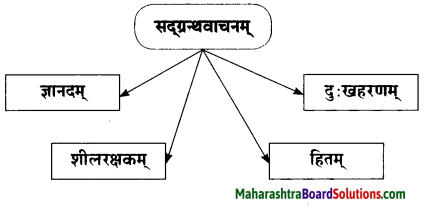
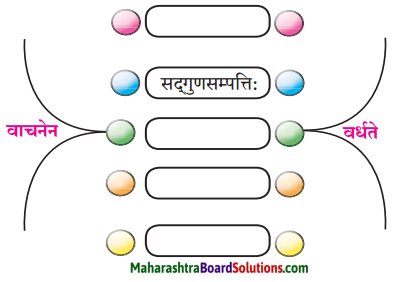
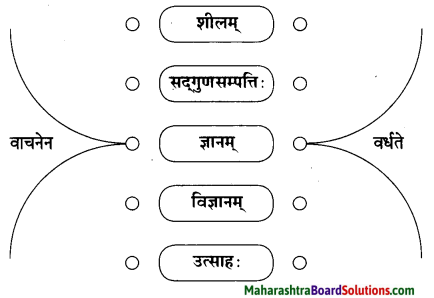
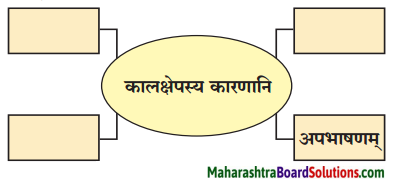
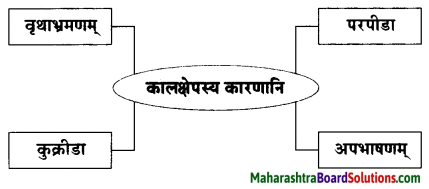
![]()
![]()
![]()
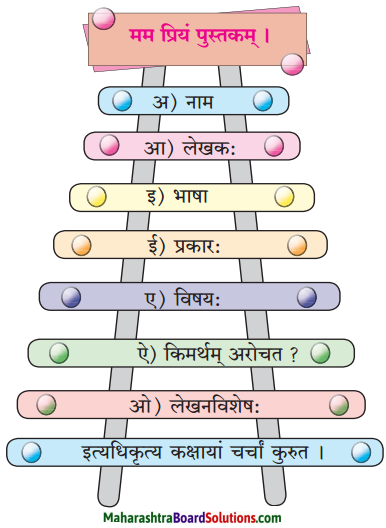
![]()
![]()
![]()
![]()
![]()










